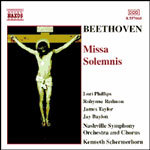
Missa Solemnis, Op. 123
 $25.00
Out of Stock
$25.00
Out of Stock6+ weeks add to cart
BEETHOVEN
Missa Solemnis, Op. 123
Jay Baylon / Lori Phillips / Robynne Redmon / James Taylor / Nashville Symphony Chorus & Orchestra / Kenneth Schermerhorn
[ Naxos / CD ]
Release Date: Friday 2 April 2004
This item is currently out of stock. It may take 6 or more weeks to obtain from when you place your order as this is a specialist product.
"The Symphony Chorus is a splendid group who sing with confidence... The four soloists are really very good"
(MusicWeb)
"The Symphony Chorus is a splendid group who sing with confidence... The four soloists are really very good... Mezzo Robynne Redmon sings with fine, firm tone and great commitment. Tenor James Taylor is excellent too... their quartet singing is often of a very high quality... Conductor Kenneth Schermerhorn clearly has a firm grasp of the work, and handles the architecture of the huge movements very well, with tempi that allow the character of the music to be felt strongly.
-- Gwyn Parry-Jones, www.musicweb.uk.net, February 2004
The Missa Solemnis is scored for an orchestra with the usual pairs of woodwind instruments, double bassoon, four horns, three trombones, trumpets and timpani, strings and organ, together with four solo singers and chorus. The work is conceived as a whole and has been described as a five-movement symphony, but in spite of its length it still has a possible liturgical use, as at first intended. The D major Kyrie is marked Assai sostenuto and Mit Andacht (With devotion), with the superscription Von Herzen - möge es wieder - zu Herzen gehen! (From the heart - may it go again to the heart!). In the first section the soloists and choir combine in prayer, leading to the central B minor Christe eleison, led by the soloists. The third Kyrie, directed to the third person of the Trinity, the Holy Spirit, is a greatly varied recapitulation.
The Gloria opens with a burst of triumph, hushed for a moment at the words et in terra pax hominibus bonae voluntatis, before the jubilant return in laudamus te. In a movement where the influence of Handel is perceptible, the clause glorificamus te provides a place for fugal writing. There is a change of mood and of key, to B flat major as the soloists introduce the words gratias agimus tibi. The woodwind and horns start the C major Larghetto setting of qui tollis peccata mundi, led by the soloists. The original key is restored, before further modulation and word-painting at the words miserere nobis, a plea reinforced by the trombones. A sudden hush is followed by a triumphant quoniam tu solus sanctus, in a phrase echoing Mozart's Tuba mirum. In gloria Dei Patris provides the opportunity for a great fugue which makes use of all possible contrapuntal techniques, before a final unliturgical repetition of the opening words, Gloria in excelsis Deo.
The Credo, in B flat major, sets the opening statement of belief to a melody of strong contrapuntal possibilities, as voice after voice enters, before finally uniting on the words unum Deum. There is a sudden quietness for et invisibilium, after which the Credo resumes, with the return of the opening motif. Ante omnia saecula brings a pianissimo, soon interrupted by Deum de Deo, followed by the fugal consubstantialem Patri. There is further word-painting in what follows, leading to the necessary tranquil devotion of et incarnatus est, with its reduced orchestration and flute ornamentation, until the dramatic solo tenor announcement, et homo factus est. There is starker drama at the Crucifixus, and the sombre passus et sepultus est, tension dispelled at Et resurrexit tertia die, leading to the fugal entries of the ascending et ascendit in coelum. The trombones suggest the Last Trump at judicare vivos et mortuos. The Credo motif returns accompanied by the later clauses of the Creed and the double fugue at et vitam venturi saeculi, a monumental conclusion to this declaration of belief.
The Sanctus, an Adagio, again marked Mit Andacht, with the violins at first silent, has the entry of the solo voices preceded by the chords of the trombones. The sense of awe, stressed by the tremolo of the lower strings, is interrupted by the joyful Pleni sunt coeli and fugato Osanna. There is a meditative Praeludium, scored for flutes, bassoon, lower strings and organ, designed for the part of the Canon of the Mass before the Consecration. A violin solo, accompanied by flutes then clarinets, ushers in the Benedictus, the instrumental element continued with the entry of the solo voices in an extended, almost pastoral movement.
The B minor Agnus Dei is introduced by the bass soloist, joined by other voices in a prayer for mercy. The final petition of the Agnus Dei, has the epigraph Bitte um innern und äussern Frieden (Prayer for inner and outward peace), words that some have seen as a reflection of Beethoven's own inner turmoil, particularly his bitter quarrel with his brother's widow over the care of his nephew. There is something Mahlerian about the trumpets' entry that heralds the return of the original petition, followed by the fugal treatment of the plea for peace. An orchestral passage of baroque suggestion is succeeded by a fortissimo, introducing an extended coda, in which the desire for peace remains the overriding theme.
It might be added that the conclusion also makes a more satisfactory concert ending than many purely liturgical settings of the Mass. Beethoven achieves, in a work that he subjected to much revision and over which he took the greatest care, a new musical, dramatic and liturgical synthesis, absorbing the earlier examples of such writing, from Bach and Handel, Mozart and Haydn, to the more immediately contemporary, Cherubini and Spontini. He creates here something that is both old and completely new, an apotheosis comparable to that he brought about with his last symphony.
- Keith Anderson
